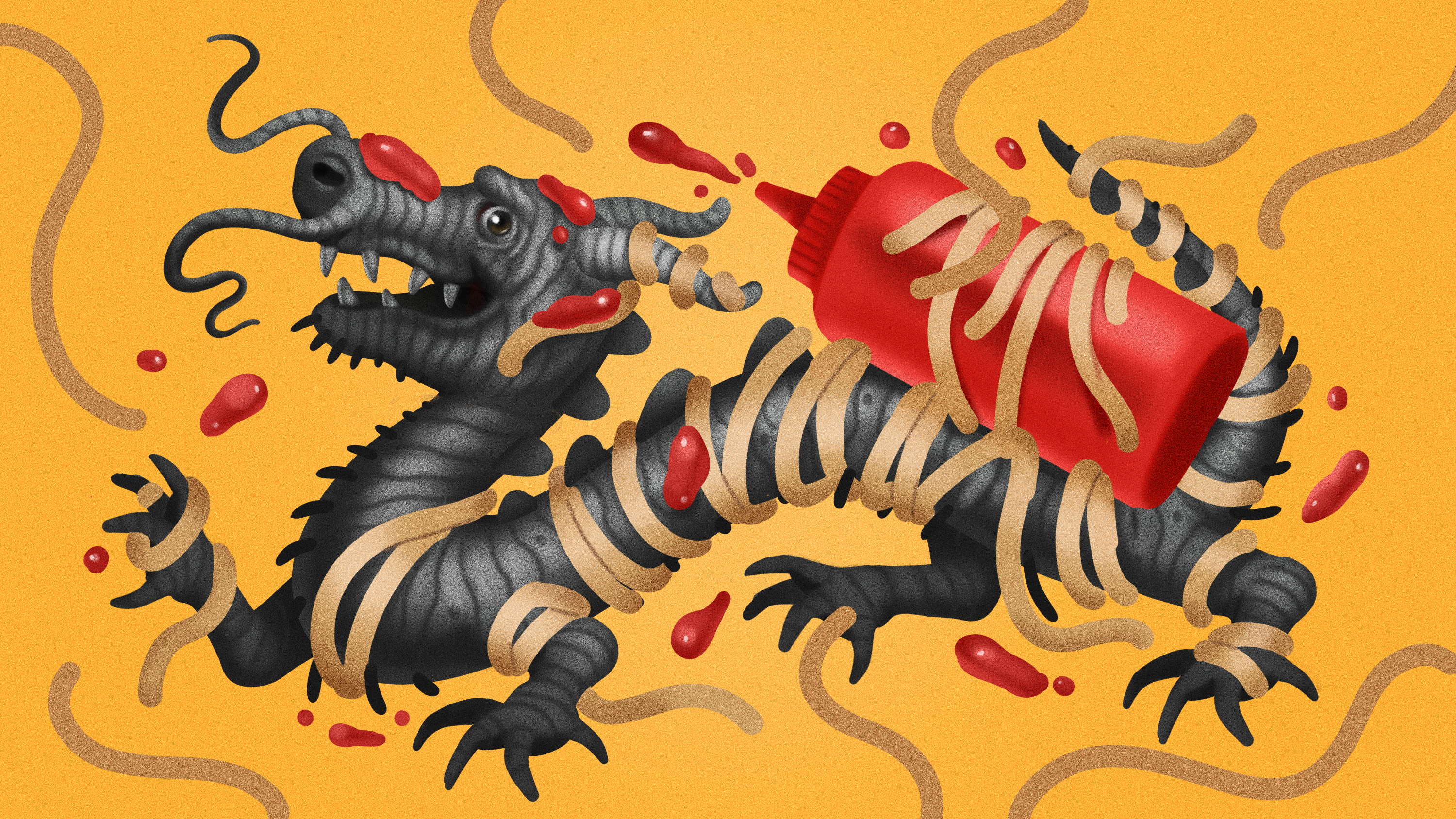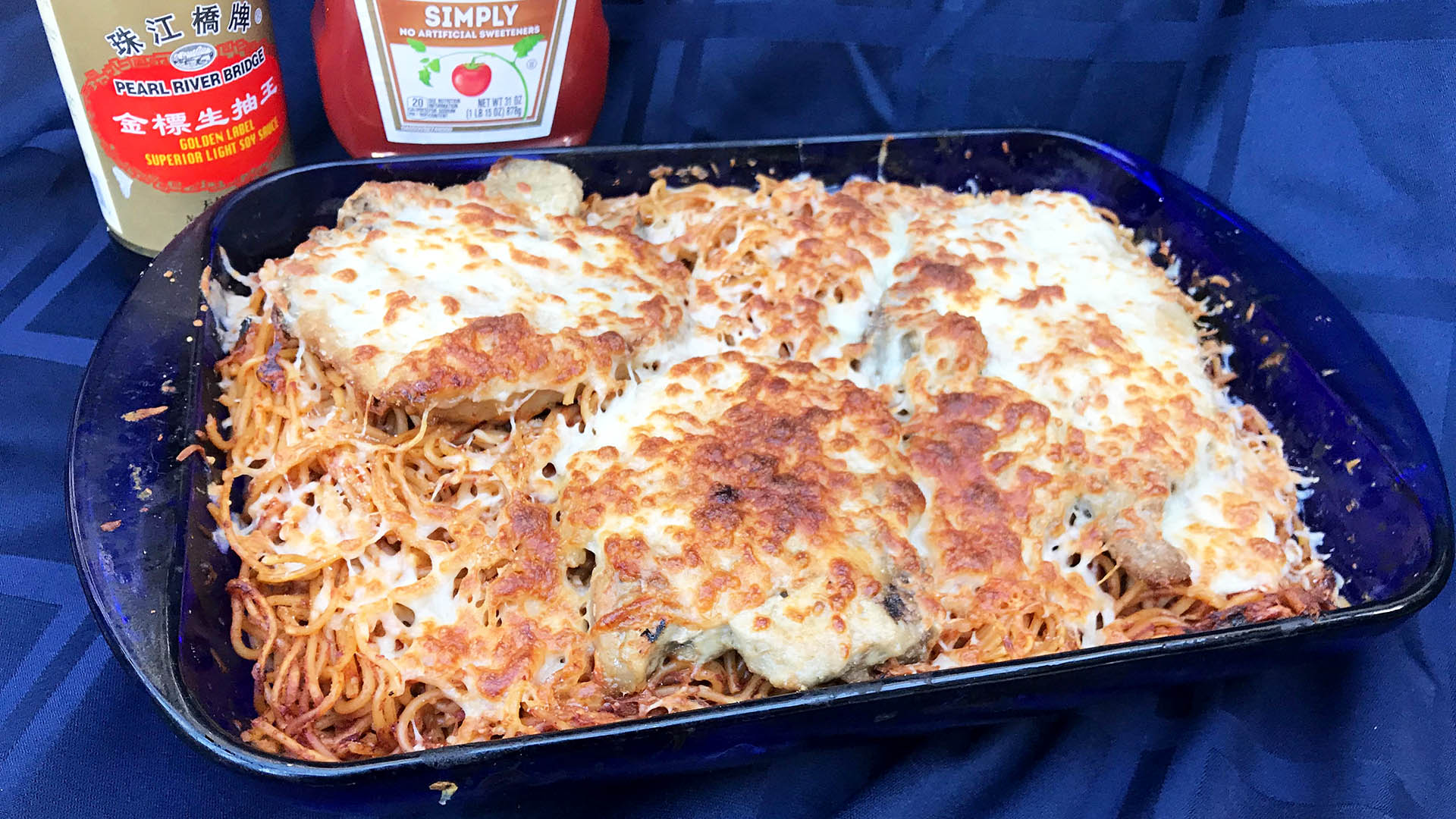The Key Ingredient In Hong Kong Spaghetti Is Ketchup, And It's Brilliant
Today I am going to suggest you cook a dish that puts ketchup on spaghetti. Your instincts might tell you to close this recipe's tab immediately and wander off to another part of the internet where people aren't putting ketchup on spaghetti, but fight those instincts! I would not be here to convince you that ketchup on spaghetti is delicious if I did not wholeheartedly believe this to be true, and I am willing to stake my good Italian name on it.
Where I come from, merely the notion of ketchup spaghetti would be considered worse than madness—it would be considered heresy. I am certain that every single one of you are familiar with the section of Brooklyn in which I grew up, as well as the "colorful" types of people I was surrounded by, thanks to movies like Goodfellas and The Godfather. You can definitely picture my neighborhood when you think of Saturday Night Fever, even if you've never actually seen the movie. We all know "the strut:"
This was a place where it was impossible to comprehend the words ketchup and spaghetti in the same sentence, much less in the same dish. I held onto this prejudice for over 30 years before taking an accidental leap of faith, one that was spurred by the sight of an astonishing amount of melted cheese. I found myself in need of a decent meal one late night after work—late enough that bars were still open, but the restaurants had closed. Nights like that, I usually headed to one of New York City's many Chinatowns (I believe there are nine of them now), because no matter what time it is, you will almost always be able to find a meal in Chinatown that is not merely edible, but flat-out excellent. I found a parking spot across the street from a bustling restaurant called Hong Kong Café, figuring it was no different from the dozens of other restaurants up and down the street. God forgive me, I was such a simple idiot.
Before that night, I had no knowledge of the café cuisine of Hong Kong, nor did I anticipate how it would change my views on so many foods, including ketchup and spaghetti. The simplest explanation I can give you: You know how a lot of Chinese takeout food in America is "not really Chinese"? Well in Hong Kong, they cook American takeout food that's "not really American." In an instant, Hong Kong café food will forever trash your precious notions of authenticity or provenance. It is a glorious amalgamation of cuisines that have been deposited there through centuries of trade, colonialism, immigration, and exploration. There are thousands of stories to be told, and one small café menu could barely scratch the surface. I will never be able to know everything I want to about Hong Kong cuisine, and that excites me to no end. While I scanned the menu's laminate pages, trying to choose between the Spam fried rice or a curry beef stew hero, my nose detected a faint aroma of burnt cheese, causing my brain to shut down all activities that were not related to locating said burnt cheese. I shall never forget the sight of a red-vested waiter carrying a tray full of individual casserole dishes draped in thick layers of melted mozzarella, with bright red spaghetti strands peeking out the sides like they were trying to escape. I did not know what it was—I just knew that I wanted it.
The recipe I am sharing with you is what I tasted that night: seared pork chops and melted cheese laid over a bed of spaghetti with a sweet, ketchup-spiked sauce. I realized the flaw in my earlier, dumber way of thinking: No one had intended for ketchup to be a stand-in for actual tomato sauce. As our Hong Kong-born former editor-in-chief Kevin Pang explained to me, in many Asian kitchens ketchup is used not as a condiment, but as an ingredient. It's not much more than tomato paste and vinegar with a little bit of sugar. What's so controversial about that?
The recipe itself is something I've developed over time straight out of necessity: When I finally moved out of New York City a few years ago, I failed to consider it would be near impossible to find a Hong Kong-style café (or cha chaan tengs, as they're called) in the greater Baltimore/D.C. area. I've made this dish entirely to fulfill my personal needs. If you perchance have recipes of your own to share, or firsthand stories to tell about the cha chaan tengs of Hong Kong, tell me about them in the comments! I want to learn everything there is to know about the food, the history, the culture and the many, many uses of Spam (I seriously love Spam, guys). If you ever find yourself in Brooklyn and want to experience the wonders of Hong Kong cuisine yourself, I can help you out. The name has changed a few times, and I'm almost certain the restaurant doesn't have a website, but it's easy enough to find if you follow the arrow:

There's room for all sorts of people and restaurants in America. And there's room for all our spaghettis, too.
Hong Kong Cheese Baked Pork Chop Spaghetti
Pork Chops
- 1 1/2 pounds thin cut pork chops—about 1 1/2 pounds bone-in, or 1 pound boneless
- 1 Tbsp. soy sauce
- 1 Tbsp. Shaoxing cooking wine
- 1 Tbsp. sesame oil
- 1 tsp. fish sauce
- 1 tsp. rice wine vinegar
- 1/2 tsp. garlic powder
- 3 Tbsp. cornstarch
- 1 pound spaghetti
- 8 oz. shredded mozzarella
- 2 large yellow onions, Frenched
- 8 cloves garlic, minced
- 2 Tbsp. tomato paste
- 1 tsp. beef bouillon paste, like Better Than Bouillon
- 1 cup ketchup
- 1 1/2 cups water
- 1/2 tsp. Worcestershire sauce
- Fresh cracked pepper and kosher salt to taste
Spaghetti
Sauce
Marinate the pork chops
Use a fork to tenderize the pork chops—just stab the hell out of them on both sides. Have fun with it. Then move the pork chops to a 9x13" casserole dish.
Whisk together the soy sauce, Shaoxing cooking wine, sesame oil, fish sauce, rice wine vinegar, garlic powder, and cornstarch until smooth. Pour the marinade over the pork chops, spread it around to make sure everything's good and covered, then marinate for 30 minutes.
Cook the pork chops and boil the pasta water
I'm going to assume you know how to boil a pound of pasta. Now's the time to put the pot of water on the stove so it can start coming to a boil. Now is also the time to preheat your oven to 350 degrees Fahrenheit/180 degrees Celsius.
Once that's done, heat a cast iron or non-stick skillet over medium-high heat with a few tablespoons of canola oil, then sear the pork chops until they're brown—about 3 minutes on each side. Move to a plate and set aside.
Make the sauce and the spaghetti
Put another tablespoon of oil in the skillet if you think it needs it, then add the onions and fry over high heat until they're very dark brown, just short of blackened. Turn the heat down to medium, add the minced garlic, and cook while stirring for a minute or so until it becomes golden and fragrant. Next, add the tomato paste and cook for another minute while stirring around the pan until the paste begins to caramelize and darken slightly. Then add the water, beef bouillon, ketchup, and Worcestershire sauce. Turn the heat back up to high and bring the sauce to a boil, then reduce the heat to a simmer for five minutes.
While the sauce is simmering, cook the spaghetti until al dente. Drain—reserving a cupful of cooking water—and toss with the ketchup sauce.
Assemble and bake
Wash the 9x13" casserole dish you marinated the pork chops in, then pour in the spaghetti and spread it out evenly. Place the pork chops on top, then cover it with as much mozzarella as you want. Bake until the cheese is melted, then throw it under the broiler for a minute or so if you'd like to crisp it up. Serve immediately.

